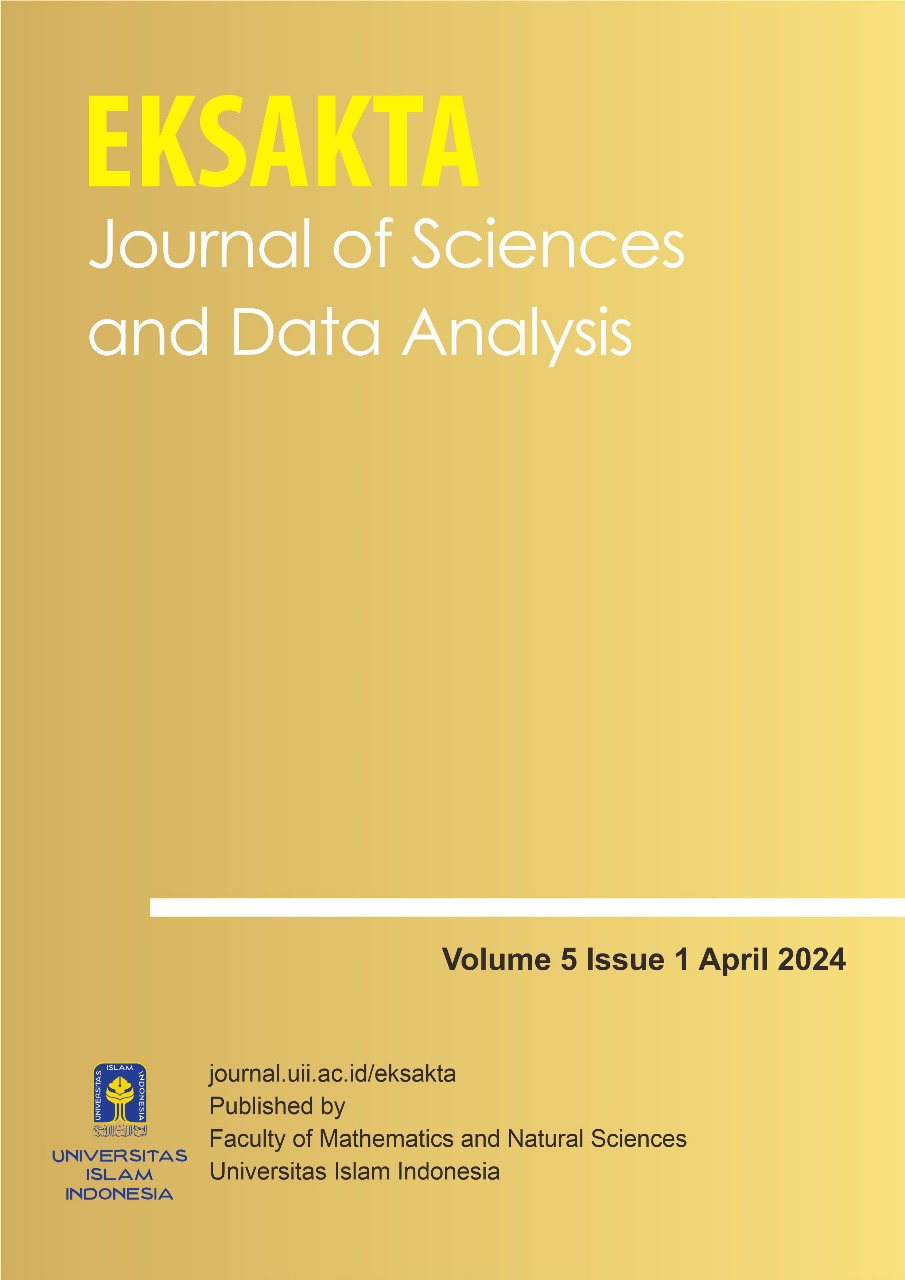Main Article Content
Abstract
A healthy and prosperous life is one of the goal points listed in the Sustainable Development Goals (SDGs). To create a healthy life, support is needed in the form of equal health facilities and services for all people in all provinces of Indonesia. In fact, there are still provinces that have low levels of health service facilities. West Java is ranked last with low health service conditions. Grouping efforts are needed to identify cities or districts in West Java that deserve priority for handling health facilities. In this study, the K-Means++ method was used to group health facilities based on cities or districts in West Java Province. Based on the grouping results, 3 clusters were obtained, namely cluster 1 for groups with low health facilities with 18 cities/regencies as members, cluster 2 for groups with moderate health facilities with 7 cities/regencies, and cluster 3 for groups with high health facilities with 2 cities/regencies
Keywords
Article Details
References
- S. Arifin, T. Lestarisa, R. A. A. H. S. P. S, A. Widiarti, D. Mutiasari, and H. Jelita, Sistem Pelayanan Kesehatan Masyarakat, 1st ed. Yogyakarta: CV Mine, 2022.
- Y. Pusparisa, “Bagaimana Kondisi Layanan Kesehatan di Indonesia?,” databoks, 2020. https://databoks.katadata.co.id/datapublish/2020/04/03/bagaimana-kondisi-layanan-kesehatan-di-indonesia.
- A. Rahim, I. Pasari, and M. Sutanty, “Pengaruh Pendapatan Masyarakat Terhadap Permintaan Pelayanan Kesehatan di Kabupaten Sumbawa (Studi Pada RSUD Kabupaten Sumbawa),” J. Ekon. Bisnis, vol. 10, no. 3, pp. 304–312, 2022, doi: 10.58406/jeb.v10i3.1041.
- M. Misnaniarti et al., “Ketersediaan Fasilitas dan Tenaga Kesehatan Dalam Mendukung Cakupan Semesta Jaminan Kesehatan Nasional,” J. Penelit. dan Pengemb. Pelayanan Kesehat., no. May 2019, pp. 6–16, 2018, doi: 10.22435/jpppk.v1i1.425.
- Yandrizal, D. Suryani, B. Anita, and H. Febriawati, “Analisis Ketersediaan Fasilitas Kesehatan dan Pemerataan Pelayanan Pada Pelaksanaan Jaminan Kesehatan Nasional di Kota Bengkulu, Kabupaten Seluma dan Kabupaten Saur,” J. Kebijak. Kesehat. Indones., vol. 03, no. 02, pp. 103–112, 2014.
- Z. A. Noor, T. D. Sekarningrum, and T. Sulistyaningsih, “Disparitas perkotaan-pedesaan: pemerataan dalam akses layanan kesehatan primer untuk lansia selama pandemi Covid-19,” JPPI (Jurnal Penelit. Pendidik. Indones., vol. 7, no. 4, p. 576, 2021, doi: 10.29210/020211249.
- U. F. Laili, C. Umatin, and M. U. Ridwanulloh, “Analisis Potensial Drop Out Mahasiswa Dengan K-Means++ Clustering Dalam Upaya Peningkatan Kualitas IAIN Kediri,” Paedagoria J. Kajian, Penelit. dan Pengemb. Kependidikan, vol. 14, no. 2, pp. 145–153, 2023.
- A. R. Hayati, M. Hani’ah, and I. Kusumaning, “Comparison of Result Clustering Study Case Posyandu With The Scalable K Means ++ Clustering Method,” Conf. Senat. STT Adisutjipto Yogyakarta, vol. 6, pp. 263–272, 2020, doi: 10.28989/senatik.v6i0.408.
- N. Nugroho and F. D. Adhinata, “Penggunaan Metode K-Means dan K-Means++ Sebagai Clustering Data Covid-19 di Pulau Jawa,” Teknika, vol. 11, no. 3, pp. 170–179, 2022, doi: 10.34148/teknika.v11i3.502.
- C. M. Fikri, F. E. M. Agustin, and F. Mintarsih, “Pengelompokan Kualitas Kerja Pegawai Menggunakan Algoritma K-Means++ Dan Cop-Kmeans Untuk Merencanakan Program Pemeliharaan Kesehatan Pegawai Di Pt. Pln P2B Jb Depok,” Pseudocode, vol. 4, no. 1, pp. 9–17, 2017, doi: 10.33369/pseudocode.4.1.9-17.
- R. Nainggolan, R. Perangin-Angin, E. Simarmata, and A. F. Tarigan, “Improved the Performance of the K-Means Cluster Using the Sum of Squared Error (SSE) optimized by using the Elbow Method,” J. Phys. Conf. Ser., vol. 1361, no. 1, 2019, doi: 10.1088/1742-6596/1361/1/012015.
References
S. Arifin, T. Lestarisa, R. A. A. H. S. P. S, A. Widiarti, D. Mutiasari, and H. Jelita, Sistem Pelayanan Kesehatan Masyarakat, 1st ed. Yogyakarta: CV Mine, 2022.
Y. Pusparisa, “Bagaimana Kondisi Layanan Kesehatan di Indonesia?,” databoks, 2020. https://databoks.katadata.co.id/datapublish/2020/04/03/bagaimana-kondisi-layanan-kesehatan-di-indonesia.
A. Rahim, I. Pasari, and M. Sutanty, “Pengaruh Pendapatan Masyarakat Terhadap Permintaan Pelayanan Kesehatan di Kabupaten Sumbawa (Studi Pada RSUD Kabupaten Sumbawa),” J. Ekon. Bisnis, vol. 10, no. 3, pp. 304–312, 2022, doi: 10.58406/jeb.v10i3.1041.
M. Misnaniarti et al., “Ketersediaan Fasilitas dan Tenaga Kesehatan Dalam Mendukung Cakupan Semesta Jaminan Kesehatan Nasional,” J. Penelit. dan Pengemb. Pelayanan Kesehat., no. May 2019, pp. 6–16, 2018, doi: 10.22435/jpppk.v1i1.425.
Yandrizal, D. Suryani, B. Anita, and H. Febriawati, “Analisis Ketersediaan Fasilitas Kesehatan dan Pemerataan Pelayanan Pada Pelaksanaan Jaminan Kesehatan Nasional di Kota Bengkulu, Kabupaten Seluma dan Kabupaten Saur,” J. Kebijak. Kesehat. Indones., vol. 03, no. 02, pp. 103–112, 2014.
Z. A. Noor, T. D. Sekarningrum, and T. Sulistyaningsih, “Disparitas perkotaan-pedesaan: pemerataan dalam akses layanan kesehatan primer untuk lansia selama pandemi Covid-19,” JPPI (Jurnal Penelit. Pendidik. Indones., vol. 7, no. 4, p. 576, 2021, doi: 10.29210/020211249.
U. F. Laili, C. Umatin, and M. U. Ridwanulloh, “Analisis Potensial Drop Out Mahasiswa Dengan K-Means++ Clustering Dalam Upaya Peningkatan Kualitas IAIN Kediri,” Paedagoria J. Kajian, Penelit. dan Pengemb. Kependidikan, vol. 14, no. 2, pp. 145–153, 2023.
A. R. Hayati, M. Hani’ah, and I. Kusumaning, “Comparison of Result Clustering Study Case Posyandu With The Scalable K Means ++ Clustering Method,” Conf. Senat. STT Adisutjipto Yogyakarta, vol. 6, pp. 263–272, 2020, doi: 10.28989/senatik.v6i0.408.
N. Nugroho and F. D. Adhinata, “Penggunaan Metode K-Means dan K-Means++ Sebagai Clustering Data Covid-19 di Pulau Jawa,” Teknika, vol. 11, no. 3, pp. 170–179, 2022, doi: 10.34148/teknika.v11i3.502.
C. M. Fikri, F. E. M. Agustin, and F. Mintarsih, “Pengelompokan Kualitas Kerja Pegawai Menggunakan Algoritma K-Means++ Dan Cop-Kmeans Untuk Merencanakan Program Pemeliharaan Kesehatan Pegawai Di Pt. Pln P2B Jb Depok,” Pseudocode, vol. 4, no. 1, pp. 9–17, 2017, doi: 10.33369/pseudocode.4.1.9-17.
R. Nainggolan, R. Perangin-Angin, E. Simarmata, and A. F. Tarigan, “Improved the Performance of the K-Means Cluster Using the Sum of Squared Error (SSE) optimized by using the Elbow Method,” J. Phys. Conf. Ser., vol. 1361, no. 1, 2019, doi: 10.1088/1742-6596/1361/1/012015.




